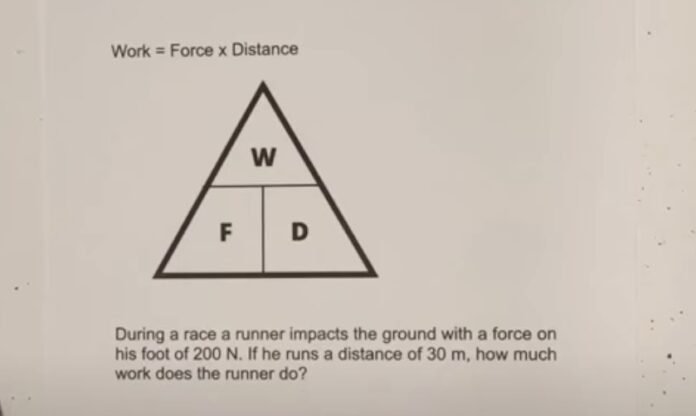Introduction
The unit of work is defined by Joules (J). When you displace an object with a force of 1 Newton (N), by a distance of 1 Metre (m), then the work done is equal to 1 Joule (J). In terms of formula, it is written as:
Or
In the above formula, work is represented by the symbol ‘W’, force is represented by the symbol ‘F’, and displacement is represented by the symbol ‘s’. Further in this article, you will learn about the definition of work, types of work, and SI unit of work.
What is Work?
The product of force (F) applied to the distance it is displaced (s) is known as Work (W). Some examples include lifting objects, riding a bicycle, opening a door, etc.
Types of Work
Work is categorised into three main categories, depending on the direction of force and displacement of the object. The three types of work are:
- Positive Work
The work done in the direction of movement of an object is positive work. When the direction of force applied is the same as the direction of displacement of the object, the work done is positive.
For example, an object falling from the sky to the ground has a downward direction. Here the force applied would be gravity, which is pulling the object in a downward direction. Since the displacement and force (gravity) are in the same direction, the work done is positive.
Some other examples of positive work done are:
- Kicking a football.
- Pushing a heavy box.
- Pushing a wheelchair.
- Vehicles moving in the forward direction on the road.
- Balls threw by children at each other.
- Negative Work
When the work is done in the direction opposite to the movement of the object, the work done is negative. That is if the force is applied in the forward direction, but the object moves in the backward direction, in such cases, the work done is negative.
For example, if you throw a ball up in the sky, the work done will be negative. It is because the ball is moving in an upward direction, whereas a downward force (gravity) is being acted on the object.
Some other examples of negative work are:
- When we walk on a surface, the work done is negative because frictional force is acting in the opposite direction of feet.
- Pulling water from the well. Here, a downward force acts on the rope, but the bucket moves in the upward direction.
- When we jump, the work done is negative because gravitational force acts on the body pulling you down.
- Zero Work Done
Work done is zero when either force applied on the object is zero, or the displacement of the object is zero.
For example, when you try to push the wall by applying force to it and the wall doesn’t move, the work done here is zero.
SI Unit of Work
The SI unit of work is Joules and is represented by the symbol “J”. Some points to remember are:
- When a force of 1 Newton acts on the object and displaces it by 1 Metre, then 1 Joule of work is done.
- 1 Joule = 1 Newton (N) x 1 Metre.
- Another unit of work is Newton-metre (N-m). This unit of work is not used to represent work done, as this unit (N-m) is also used to express torque.
- Newton-metre is dimensionally equal to Joule.
Below are examples to understand the unit of work a little better:
- When 1 N of force is applied to lift an object to the height of 1 m, then 1 J of work is done.
- When you apply a force of 20 N on a heavy box and it gets displaced by 5 m, then the work done is W = 20 N x 5 m, which comes out to 100 J. Therefore, the work done to displace the heavy box is 100 J.
Real-Life Examples of Unit of Work
Let’s look at some examples of work you may encounter in your daily life.
- When you push a stopped car and it moves in the forward direction, positive work is said to be done. This is since the direction of force and displacement is the same.
- Cutting vegetables with a knife also involves doing positive work. Here, the direction of force and movement of the knife is the same.
- Playing on the see-saw would be an example of negative work done since when one end pushes down, the other side goes up.
Almost every activity that you carry out in your daily life has work involved.
Recommended Articles:
Units Of Measurements – Definition And Metric
Physics – Universal Law Of Gravitation
Physics – Uses Of Diode – Definition and Types
Uses of Electromagnetic – Definition, Properties, Effects, and Application
Physics – Uses Of Convex Lens and Types
The measure of the displacement of an object to a distance ‘s’, multiplied by force applied ‘F’, defines work. Depending upon the direction of Force and Displacement of an object, work is categorized into three types. They are positive, negative, and zero work. The SI Unit of work is Joules and is represented by the symbol ‘J’. Work depends upon two factors: the force applied to an object and the object's displacement. N-m or Newton-metre is used as the SI unit of torque. To avoid confusion, the unit of work is defined by Joules (J), which is equivalent to Newton-metre (N-m). Unit of Work FAQs
What is the definition of work?
What are the different types of work?
What is the SI Unit of work?
What factors does work depend upon?
Why is N-m not used as the SI unit of work?
